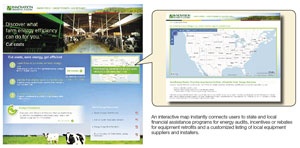A collaboration between the Innovation Center for U.S. Dairy and the USDA’s Natural Resources Conservation Service (NRCS) has yielded a new online tool that connects dairy producers to the resources they need to save energy and, in turn, save money on their operations. “This is a great opportunity to show producers how we are using checkoff dollars to join with other organizations and bring information to the table,” says Dan Rice, a dairy producer from Firth, Nebraska.
The SaveEnergy online resource brings together financial assistance programs and educational materials to help dairy producers reduce on-farm energy use and related costs. The free tool available at USDairy.com/SaveEnergy is part of the U.S. Dairy Sustainability Commitment, an effort established by dairy producers to reduce environmental impact and create business value across the supply chain.
Click here or on the image at right to view it at full size in a new window.
Robert Madeja, business analyst of sustainability for the Innovation Center for U.S. Dairy, says dairy producers have a tendency to first look at renewable energy opportunities. However, the better place to begin is with efficiency savings because the cost and time investments are significantly less.
The website brings these opportunities to light with an easy three-step process:
1. Learn how to cut costs of on-farm energy use.
2. Decide if an energy audit is right for the dairy operation.
3. Find financial assistance for on-farm energy audits and equipment updates.
“The thing I like best about the website is its educational piece. Before using it, I had no idea how much of my electric bill was used to heat water or keep the lights on,” Rice says. “I never looked at energy as something I could control.”
Rice is a partner in Prairieland Dairy. Four families operate this 1,500-cow farm that also includes a compost operation and processing facility in Firth, Nebraska.
In the second step of the process, he learned an energy audit would be valuable for his farm.
On-farm energy audits are tailored to each agricultural operation’s primary energy uses. The audits help producers determine the amount of energy used by the entire operation and also identify short-term and long-term measures producers can implement to conserve energy and achieve greater energy efficiencies. Typically an audit will identify 10 to 30 percent in energy cost savings.
The audit at Prairieland Dairy suggested an investment of $50,000 in new lighting. The overall cost was higher than what Rice and his partners wanted to spend, so instead they are replacing the farm’s 10-year-old light fixtures with new high-efficiency lighting individually on an as-needed basis.
Energy efficiency is now top of mind with other equipment upgrades, such as a new geothermal heating and cooling system. The dairy also went so far as to extend the efficiency mindset to the purchase of a new mixer wagon that had better fuel efficiency.
“This is one more way I can look at my operation’s costs and be more competitive in the marketplace,” Rice says.
He found the site to be very user-friendly, especially the collection of contact information to help with funding.
In the third step, a finder tool uses an interactive map that instantly connects users to state and local financial assistance programs for energy audits, incentives or rebates for equipment retrofits and a customized listing of local equipment suppliers and installers.
“Quite simply, our goal is to connect more dairy producers to energy savings,” said Erin Fitzgerald, senior vice president of sustainability for the Innovation Center for U.S. Dairy.
“Financial assistance, programs and application requirements vary from state to state and can come from multiple sources including utility companies. By aggregating all of the different offerings in one place, we hope to reduce time, frustration and confusion for producers who want to evaluate all options.”
One source of funding is NRCS. According to Rebecca MacLeod, NRCS national energy efficiency liaison, the beginning of a new fiscal year on October 1 means the service has funds available to offset the expense of an energy audit.
Depending on the size of the operation, about 75 percent of the audit cost can be covered. NRCS also has funds available to aid in the implementation of audit recommendations.
MacLeod adds this website is not just geared towards dairy producers, but also to field staff representatives who work with them.
“We are pushing this for our own NRCS field staff to use too,” she says. “They are not as familiar with energy audits, as it’s a relatively new field.”
An energy audit may not be needed for every farm. (The website can help determine this for each individual operation.) If you find you do not need an audit, Rice mentions you may be a great candidate for the industry’s sustainability awards. To learn more about these awards, click here . PD
PHOTOS:
MIDDLE RIGHT: An interactive map instantly connects users to state and local financial assistance programs for energy audits, incentives or rebates for equipment retrofits and a customized listing of local equipment suppliers and installers.

Karen Lee
Progressive Dairyman
Midwest Editor
karen@progressivedairy.com







